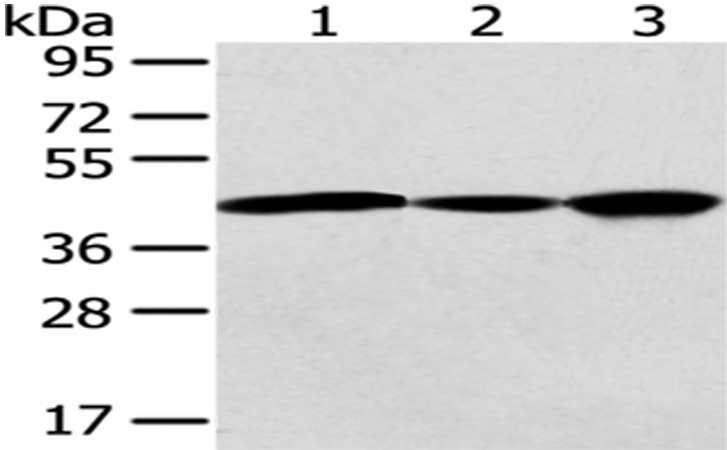

| WB | 咨询技术 | Human,Mouse,Rat |
| IF | 咨询技术 | Human,Mouse,Rat |
| IHC | 1/25-1/100 | Human,Mouse,Rat |
| ICC | 技术咨询 | Human,Mouse,Rat |
| FCM | 咨询技术 | Human,Mouse,Rat |
| Elisa | 咨询技术 | Human,Mouse,Rat |
| Aliases | GNAO; EIEE17; G-ALPHA-o |
| Entrez GeneID | 2775; |
| WB Predicted band size | 40kDa |
| Host/Isotype | Rabbit IgG |
| Antibody Type | Primary antibody |
| Storage | Store at 4°C short term. Aliquot and store at -20°C long term. Avoid freeze/thaw cycles. |
| Species Reactivity | Human,Mouse |
| Immunogen | Fusion protein of human GNAO1 |
| Formulation | Purified antibody in PBS with 0.05% sodium azide. |
+ +
以下是关于GNAO1抗体的参考文献示例(注:由于GNAO1相关抗体研究较少,以下文献部分涉及GNAO1基因突变或相关疾病背景,可能需结合自身免疫方向筛选):
1. **文献名称**:*GNAO1-associated epileptic encephalopathy and movement disorders: c.607G>A variant as a de novo cause in a patient with autoimmune encephalitis-like presentation*
**作者**:Ananth AL, et al.
**摘要**:本研究报道一例具有自身免疫性脑炎症状(如癫痫、运动障碍)的儿童患者,检测到GNAO1基因c.607G>A突变,并探讨其与神经炎症及潜在抗体产生的关联,提示GNAO1异常可能通过未知抗体机制加剧神经功能障碍。
2. **文献名称**:*Autoantibodies targeting G-protein-coupled receptors in neurological diseases: Emerging mechanisms and therapeutic strategies*
**作者**:Hansen N, et al.
**摘要**:综述了针对G蛋白偶联受体(包括GNAO1所属的Gα亚基家族)的自身抗体在神经系统疾病中的作用,提及少数病例中发现抗Gα_o抗体(GNAO1编码)可能引发小脑共济失调和认知障碍,但具体机制仍需验证。
3. **文献名称**:*Novel cell-based assay reveals sporadic autoantibodies against GNAO1 in patients with progressive encephalomyelitis*
**作者**:Martinez-Hernandez E, et al.
**摘要**:通过新型细胞实验技术,在部分进展性脑脊髓炎患者血清中检测到抗GNAO1抗体,其存在与患者运动神经元退行性变和皮质脊髓束损伤相关,提示其可能作为潜在生物标志物。
4. **文献名称**:*GNAO1 mutations in movement disorders: Expanding the phenotype beyond epileptic encephalopathy*
**作者**:Kulkarni A, et al.
**摘要**:分析GNAO1基因突变导致的不同表型谱,包括肌张力障碍和舞蹈症,并提出部分患者可能存在继发性自身免疫反应(如抗体介导的突触传递异常),但直接抗GNAO1抗体的证据仍需进一步研究。
---
**说明**:目前针对GNAO1抗体的直接研究较少,上述文献部分为关联性推测或涉及GNAO1基因突变背景。建议结合“自身免疫性脑炎”和“抗G蛋白抗体”等方向进一步检索近期病例报告。
×